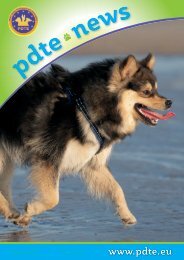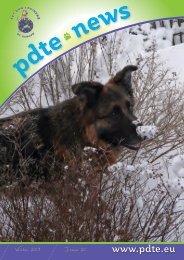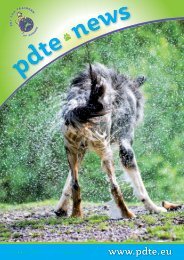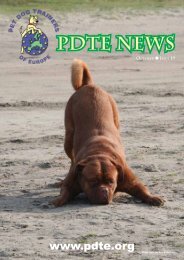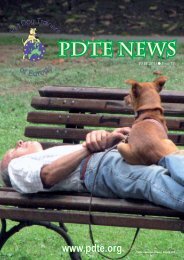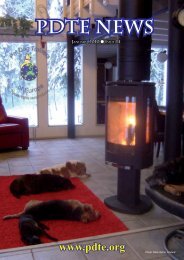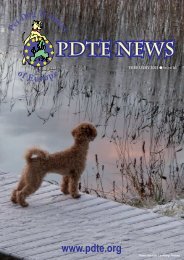PDTE 2017 Winter Newsletter
You also want an ePaper? Increase the reach of your titles
YUMPU automatically turns print PDFs into web optimized ePapers that Google loves.
Should your dog wear a<br />
coat in winter?<br />
• Thin dogs - they do not have a protective layer of fat<br />
• All greyhounds - they are invariably very cold-sensitive<br />
• Old dogs - they no longer have a strong immune system, they<br />
are more sensitive to cold, and may already be burdened with<br />
health issues<br />
• Puppies - they cool down very quickly, and do not yet have a<br />
fully developed immune system. Puppies very often suffer from<br />
bladder infections<br />
• Sick dogs - their immune system is already burdened, any<br />
further weakening is taking on their substance. These include<br />
especially dogs with organic diseases, eg heart problems and<br />
kidney weaknesses.<br />
• Dogs with thyroid disease - they are particularly sensitive<br />
to cold<br />
• Dogs with musculoskeletal problems (spondylosis, HD, ED, etc.)<br />
• Generally cold-sensitive dogs – like with humans!<br />
• Fresh imported dogs from southern countries<br />
• Dogs fresh from the groomers.<br />
the water is removed from the body surface by heat conduction<br />
and cooled accordingly.<br />
Therefore the rule: the dog should be dressed as soon as people<br />
put on their winter jackets, but at the latest when wearing scarf<br />
and gloves.<br />
What makes a good suit?<br />
Unfortunately, there is a staggering number of nonsensical<br />
rubbish on the market. For example, the turtle shell: wadded at<br />
the top, at the bottom only a strap that protects neither heart nor<br />
shoulders. Or there are actually hooded jackets that simply pay<br />
homage to the childish scheme.<br />
Dogs are very sensitive about equipment. They quickly feel<br />
uncomfortable, so the suits must be functional and comfortable.<br />
A good suit...<br />
• adapts to body movements - the dog can move freely. Ideally, it<br />
fits like a second skin<br />
• covers the back, chest, neck and as many joints as possible<br />
and as much belly as possible<br />
• does not promote the development of moisture between the<br />
coat and the fabric<br />
• has a padded zipper (long hair!)<br />
• is light<br />
In former times only owner of small dogs have been attracted, but today also large dogs with high-end<br />
clothing are to be found in winter. Here are the most frequent questions on the subject:<br />
Dog coats - is not that just a fashion trend?<br />
Dog clothing is increasingly trendy, but not for fashion reasons.<br />
Through extensive research, we know much more about animal<br />
health. Cold has a negative effect on many (pre-) illnesses, and<br />
can make the dog sick or even sicker. Hypothermia is a serious<br />
emergency.<br />
But in the old days dogs did not need coats!<br />
In the past, dogs lived in kennels. They built a protective winter<br />
coat over the fall, which warmed them like a thick fur coat. Today,<br />
our dogs live in the house, where they spend at least 20 hours of<br />
24 hours at an average of 21 degrees Celsius. In the majority of<br />
such warm temperatures, an animal does not build up a winter<br />
coat in this sense. Although they experience a change of coat,<br />
the enormously warming undercoat is formed only to a very<br />
limited extent.<br />
This difference can most clearly be seen in dogs that are brought<br />
to us, for example, in winter from Eastern European animal<br />
welfare. Their coat is incredibly dense and grippy, and protects<br />
the dog like a thick wool sweater.<br />
Which dogs need a coat?<br />
• Short and thin coat dogs (Magyar Vizla, Dalmatian, Greyhound,<br />
English Pointer, German Boxer, Bloodhound, Beagle, Bull Terrier,<br />
Rhodesian Ridgeback, Doberman, French Bulldog, Whippet,<br />
Great Dane, Weimaraner, English and American Bulldog, etc.)<br />
• Dogs without an undercoat or no change of coat (all Poodles,<br />
all Bichons, Kerry Blue Terriers, Soft Coated Wheaten Terriers,<br />
Löwchen, Bedlington Terriers, Lhasa Apso, Shih Tzu, Yorkshire<br />
Terriers, Coton de Tulear, Lagotto Romagnolo, Portuguese and<br />
Spanish Water Dog, Papillon, etc.)<br />
• Small dogs (Chihuahua, all Bichons, Pug, French Bulldog,<br />
Miniature Spitz, Pekingese, Prague Rattler, Parson & Jack<br />
Russell Terrier, West Highland White Terrier, Japan Chin, All<br />
Dachshunds, Cavalier King Charles Spaniel, Cairn Terrier, Lhasa<br />
Apso, Yorkshire Terrier, Boston Terrier, etc.)<br />
But my dog does not shake or shiver!<br />
Trembling is not a sign of freezing. Trembling is a symptom of<br />
hypothermia. So, when a dog shakes, not only does it freeze, but<br />
it's already exposed to the cold for too long and / or too much.<br />
The tremor is caused by increased contraction of the muscles:<br />
the body tries to heat up again. Trembling is a signal to the brain:<br />
Attention, first stage of hypothermia! Off to the warmth!<br />
From what temperature should the dog be dressed?<br />
Not only cold is the problem, but also the wind. (The wind chill<br />
effect is caused by the convective removal of close-to-the-air and<br />
thus relatively warm air and the associated increase in the<br />
evaporation rate.) The energy required for the phase transition of<br />
• is noiseless / does not rustle with every movement.<br />
• is not smelly<br />
• is washable.<br />
Modern coats are therefore made of softshell - a material of high<br />
quality and high price. <strong>Winter</strong> sports wear softshell, because it is<br />
depending on the processing elastic, windproof, water repellent<br />
to a certain degree, cuddly, light and thin - ideal qualities for dog<br />
winter clothing. The harness can easily be fitted over it without<br />
any problems.<br />
Which brands are recommended?<br />
Only two big players (and hopefully countless small factories)<br />
make sensible clothes: Ruffwear and Hurtta. Ruffwear has the<br />
better models, Hurtta the better sizes. Pugs, French Bulldogs,<br />
Cairn Terriers and Co are in the limelight: they are extra short and<br />
extra wide, and only Wolters has some acceptable coats for them<br />
in their program.<br />
In fact, finding a good suit can be very difficult, and you should<br />
carefully make sure the dog is comfortable in his clothing.<br />
By Sonja Hoegen, dogcom, Germany<br />
8 <strong>Winter</strong> <strong>2017</strong>/18 - <strong>PDTE</strong> <strong>Newsletter</strong><br />
<strong>Winter</strong> <strong>2017</strong>/18 - <strong>PDTE</strong> <strong>Newsletter</strong> 9









